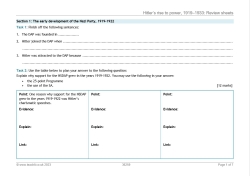Hitler's rise to power, 1919–1933: Review sheets
Last updated: 15/11/2023
Contributor: Harriet Rix

These review sheets on Hitler's rise to power test students' recall of key topic 2 in the Pearson Edexcel GCSE modern depth study 'Weimar and Nazi Germany, 1918–1939'.
They cover the following events between 1919 and 1933:
- the 25-point Programme
- Mussolini's March on Rome
- the Munich Putsch
- the Bamberg Conference
- the Wall Street Crash
- Hitler's appointment as Chancellor on 30 January 1933.
The revision tasks include:
- sentence completion
- planning a response to an exam-style question using the PEEL technique
- retrieval practice questions
- annotating a timeline / road map.
This resource is provided in two versions. The 10-page version contains space for students to write and includes answers; it is designed to be printed in A4 format. The one-page version is designed to be printed in A3 format, with students discussing the answers and writing them in their books.
See also: Hitler's consolidation of power, 1933–1939: Review sheets.
An extract from the answers:
- When was the ban on the NSDAP lifted, and how did it come about?
In February 1925, Hitler convinced the Bavarian authorities to allow the Nazi party to officially reform, with him as its leader. As part of this, Hitler formalised the party by adding a Party Treasurer and Party Secretary, expanding the party’s access to funding and legislature.
- What were Gaue, and how can they be linked to Nazi Party progress?
The Gaue were regions of Germany, and the Nazi party split Gaue agents up locally to tailor the party's message to the local concerns in each place.
- Who were the Gauleiter? Use Führerprinzip when explaining.
The Gauleiter were the regional heads of each Gaue, and they reported directly to Hitler. This was part of Führerprinzip, which maintained that Hitler had to be the absolute leader of all aspects of the Nazi Party.
All reviews
There are no reviews yet. Have you used this resource?Review this resource
